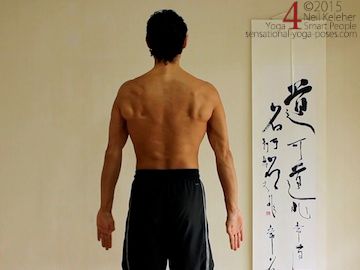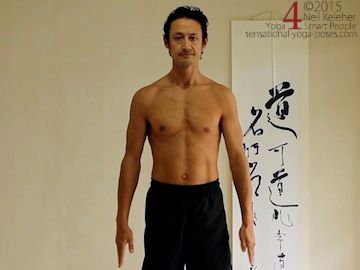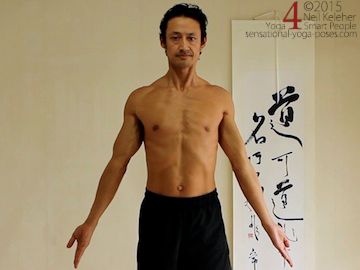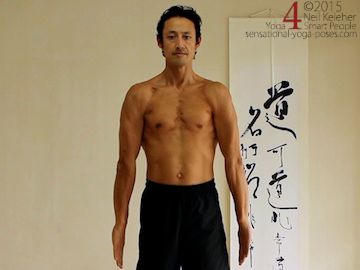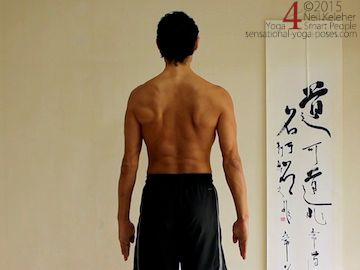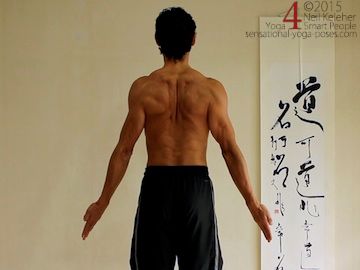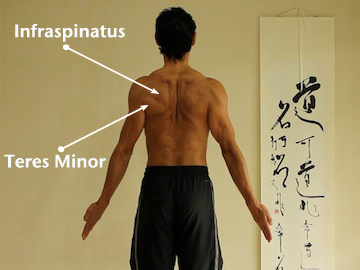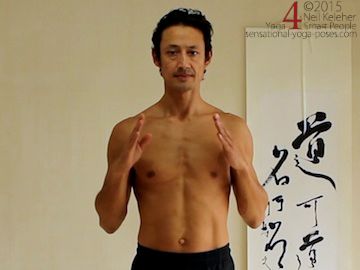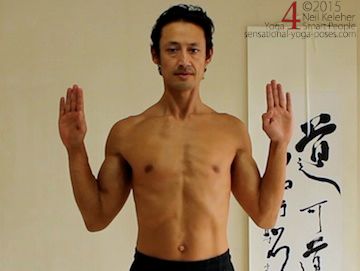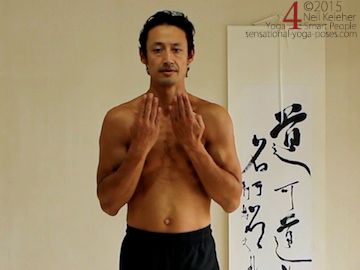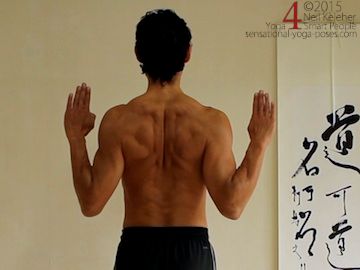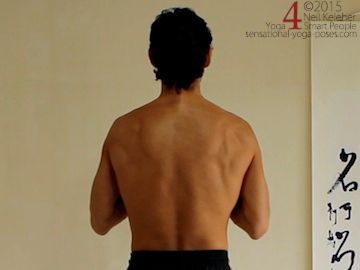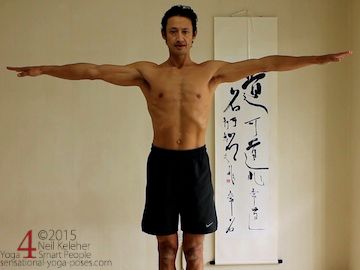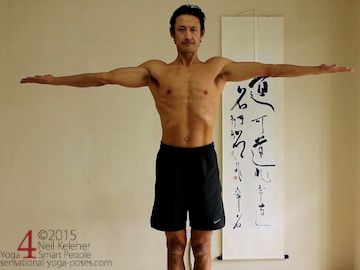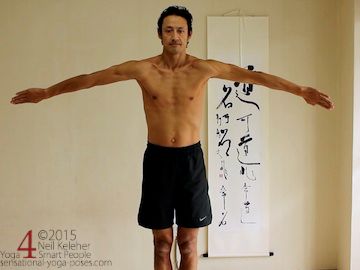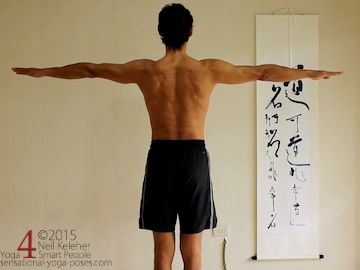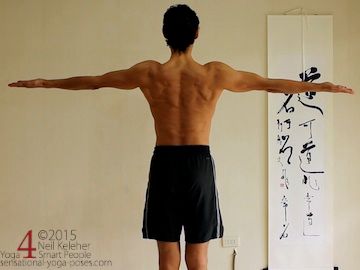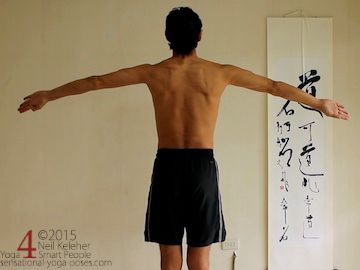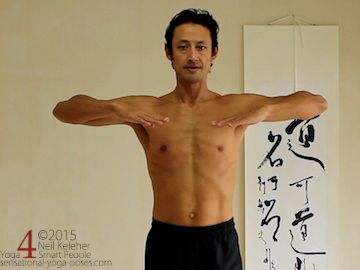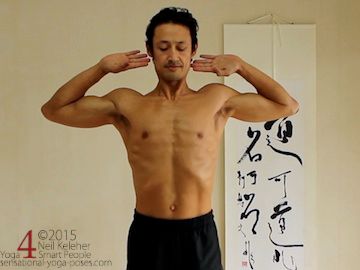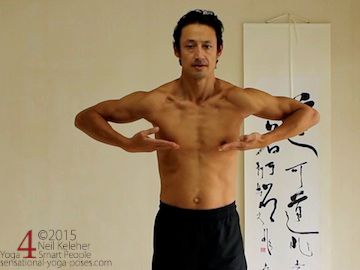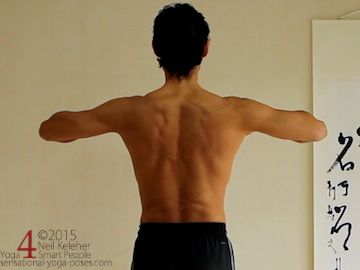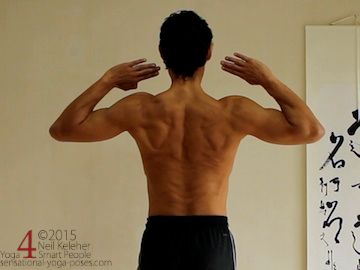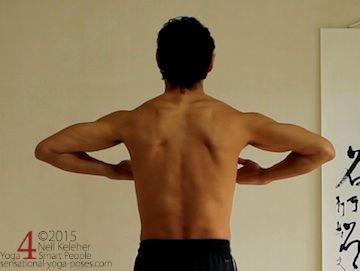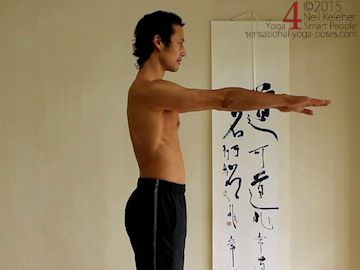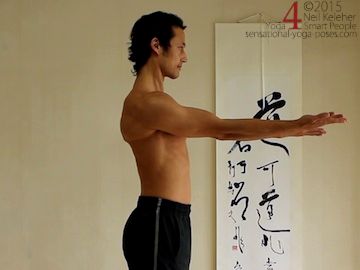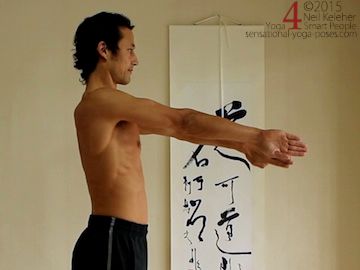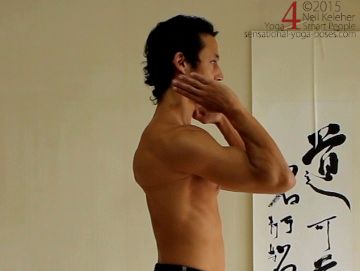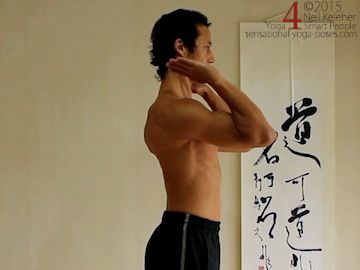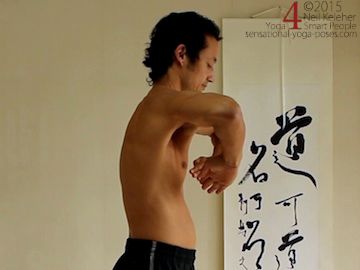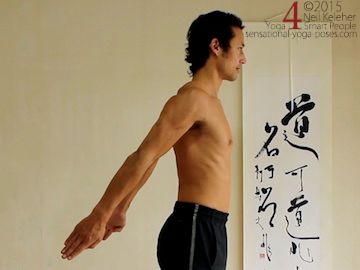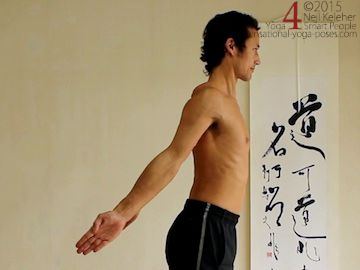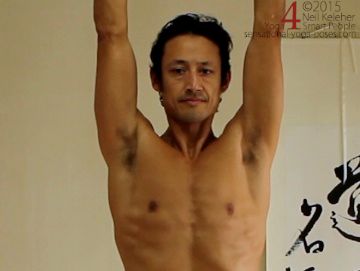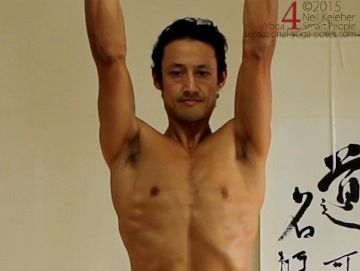Rotator Cuff Exercises
Pulling The Arm into The Shoulder Socket
The following sets of rotator cuff exercises involve either externally rotating the arm for the active phase and then relaxing or internally rotating the arm(s) for the active phase and then relaxing.
These exercises are done with the elbows straight and then bent and with the arms down by the sides, forwards, up, out to the sides and back.
Each set of exercises is breath synchronized, do the active portion as you inhale and relax while exhaling (return to the starting position).
When using both arms at the same time work at making both arms feel the same. Also try to make both sides of the ribcage and neck feel identical also.
Depending on the exact rotator cuff exercise that you are doing you may have to bend your thoracic spine forwards as you inhale but in that case then focus on opening the back of the ribcage as opposed to the front.
Repeat each exercise about 5 times.
Tips for Rotator Cuff Exercises
Make the Spine "Feel Long"
I'd suggest that the most important thing when doing the rotator cuff exercises that follow is to focus on keeping the spine long. That includes the thoracic spine and cervical spine. However rather than just keeping it long (which can be tiring) you can lengthen your spine as you inhale while at the same time doing the working phase of whichever rotator cuff exercise that you are doing. Then relax the spine, and the arm while exhaling.
Along with making your spine long, also work at making your entire arm feel long.
Make the Shoulder "Feel Open"
So that the shoulder blade is in the correct position, you can focus on reaching the shoulder away from the top of the sternum. The only exception to this would be with the arm in the down position. However, with the arms out to the sides, to the front, to the back or over the head, in all of these cases you can try to reach your shoulder joint away from the top of your sternum.
Since the shoulder joint is mounted on the shoulder joint this will have the affect of moving the shoulder blade away from the spine when the arm is reaching forward or out to the side, it will spread the shoulder blade and rotate the bottom tip outwards when reaching the arms up, and it will retract the shoulder blade (move them closer together) when the arm is reaching back.
With the arm down by the side I'd suggest simply reaching the shoulder forwards and down.
In all cases the feeling that you can look for is one of space in the shoulder, like you are creating space between the shoulder and the ribcage.
Reach Your Elbow Away from Your Shoulder
In addition to "opening" the shoulder, you can make your upper arm feel long by reaching your elbow away from your shoulder.
The idea for doing this is to add tension to the anatomy trains of the arms.
In so doing you may add a prestrech to the rotator cuff muscles making it easier to exercise them effectively. Just as importantly you'll develop a "feel" for your arm. The better you can feel your arm the more likely you are to use your arm properly in whatever exercise or activity you are doing.
Spread Your Fingers and Make Them Feel Long
One final aspect to adding connective tissue tension to the arm is to spread and lengthen your fingers. Make your hand feel as if you are pulling on a very tight glove (dish gloves may serve that purpose.
Each time you are in the active phase of a rotator cuff exercise try to make your whole arm feel long from the shoulder to the fingers. Rather than just straightening the elbow and fingers concentrate on creating a feeling of length. That feeling of length is created by tension. The tension in turn is created by trying to make your fingers and arm feel long (and trying to make your shoulder "feel" open.)
The Neck and Ribcage
Also important in these rotator cuff exercises is the neck since both the trapezius and the levator scapulae attach to this structure. If the neck is long and the skull pulled back so that it is balancing upright on the top of your cervical spine there will be less unnecessary tension in the levator scapulae and trapezius. Your scapulae will then be able to move more freely, more correctly and that in turn will allow your rotator cuff muscles to function more effectively.
Now since the cervical spine is atop the ribcage and thoracic spine, and since the scapulae also sit on top of the ribcage, the ribcage and thoracic spine should also be considered.
Normally I find that pulling the head back and up not only lengthens the cervical spine, it also naturally causes the chest to lift. In turn it can cause the upper thoracic spine to straighten. From there it can be a relatively simple matter to focus on making your spine feel long in the active phase of each exercise. Just reach it up, away from your pelvis.
To help in creating a feeling of spaciousness in your upper body, lift and expand your ribcage. Again this can happen naturally as you inhale.
Rotator Cuff Exercises
Arms Down by Sides Elbows Straight
These pictures show the different arm positions for two different rotator cuff exercises.
Starting in neutral (picture on left) inhale and externally rotate the arms (middle pictures), exhale and return to neutral. Repeat five times.
Next, starting in neutral again, inhale and internally rotate the arms (last pictures), exhale and return to neutral.
From the back you can see that external rotation activates and uses the infraspinatus and teres minor. Meanwhile external rotation activates teres major (which attaches to the front of the humerus) and subscapularis (which is located on the front of the scapula and so can't be seen.)
Arms Down by Sides Elbows Bent
With elbows bent you can focus on reaching your elbows down. It can be challenging to isolate the upper arm, you may be just rotating your forearms. So that you know that you are using your upper arm (and thus exercising your rotator cuff muscles) focus on moving the biceps or front of the arm outwards for the external rotation exercise and inwards for the internal rotation.
Arms Out to Sides
Arms To Side Elbows Bent
For this rotator cuff exercise (with elbows bent and arms to the sides) again focus on rotating your upper arm, not just your forearms. Feel the front back of your upper arm rolling in opposite directions.
Arms Forward
Arms Forward Elbows Bent
To rotate the arms with arms forwards and elbows bent, you can get the feel by rotating your arms externally with elbows straight, and then bend your elbows. (You may also find it helpful to bend your writs so that you hands have room to clear your chest.) Do the same when doing the internal rotation rotator cuff exercise.
Arms Back
Arms Up
If you look at my elbows in these two pictures you can see that in the second picture my elbows point straight ahead (arms externally rotated) while in the first picture my elbows point slightly out to the sides.
Note that internally rotating the arms with the arms up is difficult. However, if you reach the outer edge of your shoulder blade up you may find that you have room to do the internal rotation with your arms in this position. If you feel or get a sense of bone grinding against bone then don't do the internal rotation with arms up exercise.
Reminders
The rotator cuff exercises above are relatively simple. However while doing them focus on "working" while inhale and then relaxing while exhaling.
While doing the active phase of each exercise, make the arms feel long and the shoulders open so that you add tension to the connective tissue trains of your arms. In addition lengthen your spine (particularly your neck) and expand your ribcage.
When doing the active phase and relaxing phase of each exercise focus on moving smoothly between each extreme. Feel your body as you do this.
For more shoulder exercises check out the dance of shiva.
Published: 2015 07 12
